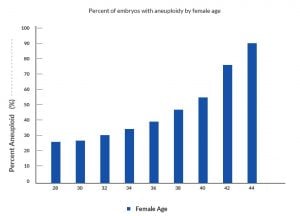What is PGS, preimplantation genetic screening?
- PGS, preimplantation genetic screening, refers to removing one or more cells from an in vitro fertilization embryo to test for chromosomal normalcy.
- PGS screens the embryo for normal chromosome number
- Humans have 23 pairs of chromosomes – for a total of 46
- Having an extra or a missing chromosome causes problems
- One example is Down syndrome which has an extra chromosome number 21. This should be detected by PGS.
- PGS does not test for a specific disease such as cystic fibrosis. That process is referred to as PGD (preimplantation genetic diagnosis).
Many human embryos are chromosomally abnormal
Several studies have shown that overall about 50% of human preimplantation embryos from IVF are chromosomally abnormal. The rate of abnormalities is affected greatly by female age, as shown in the graph below. Chromosomes in eggs from older women have a significantly increased rate of abnormalities.

What to do if the first IVF attempt fails
Problems in the past with aneuploidy screening of IVF embryos
IVF and PGS for aneuploidy (an abnormal number of chromosomes) has been used at some clinics in the United States since the mid 1990s. However, studies showed that performing embryo biopsy on day 3 and performing the genetic analysis using FISH technology (fluorescent in situ hybridization) did not result in an increase in the chance for the patient to have a successful IVF cycle.
There were 2 main problems with that approach.
Sometimes, after repeated failure to implant any embryos with IVF, women will say;
- FISH technology was usually looking at only 5 chromosomes out of 23. Therefore, the FISH test would miss many chromosomal abnormalities. This resulted in abnormal embryos being transferred after the screening test came back “normal”.
- The biopsies on day 3 were removing a cell (or 2 cells) from a 6 to 10 cell embryo. This required a relatively large hole being made in the shell of the embryo and then removal of a significant percentage of the “biomass” of that embryo (one sixth to one tenth of it removed, or more).
Recent advances allow for better IVF success rates after aneuploidy screening
Improvements in genetics technologies
Advances in the field have led to utilization of improved genetics technologies that allow assessment of all 23 pairs of chromosomes.
There are currently 4 technologies that can be utilized for assessment of normality of all 23 chromosomes:
- Next Generation Sequencing (NGS)
- Array Comparative Genomic Hybridization (aCGH)
- Single nucleotide polymorphism microarrays (SNP)
- Quantitative real time polymerase chain reaction (qPCR)
Comparative Genomic Hybridization (often referred to as CGH, or aCGH) is a microarray technology that is often used now instead of the older and far less comprehensive FISH. With microarray CGH, the actual DNA in the embryo is compared to a known normal DNA specimen utilizing thousands of specific genetic markers. This gives a more accurate result, with far fewer false normal or false abnormal results.
Some studies have determined that the error rate using array CGH technology is about 2%. FISH has an error rate of about 5-10%. Additionally, many other abnormal embryos would be reported by FISH as normal because the abnormality was in a chromosome that was not part of the FISH panel being used.
Next Generation Sequencing (NGS) is a newer technology that has been increasingly utilized for testing IVF embryos since about 2015. NGS appears to be better at detecting smaller segmental changes compared to aCGH. It is also thought to be better at detecting partial aneuploidy and small unbalanced translocations. Mosaicism is probably more likely to be discovered using Next Generation Sequencing.
Improvements in embryo biopsy techniques
Trophectoderm biopsy is done at the blastocyst stage on day 5 and 6. At this stage there are many more cells present in the embryo. This allows multiple cells to be removed from the trophectoderm (precursors to the placenta). The inner mass cells (precursors to the fetus) can be left undisturbed during the biopsy.
With trophectoderm biopsy, about 5 cells are snipped off for the genetic testing. This does not significantly weaken the embryo because it has about 70-150 cells at this stage.
The combination of these two modifications (advanced genetics and trophectoderm biopsy) has led to significantly improved pregnancy success rates for patients that want to utilize PGS for their IVF treatment.
Some clinics in the US have been using trophectoderm biopsy and the newer genetics technologies to screen embryos in some IVF patients. The results seen in some IVF programs (including ours) have been very promising.
- We are seeing substantially improved ongoing pregnancy rates in patients that are having trophectoderm biopsy performed at the blastocyst stage with subsequent freezing of their embryos.
- A frozen thawed transfer cycle is done after the chromosomal analysis results come back
Uterine receptivity issues
There is some interesting speculation that the uterine lining could be less receptive during a stimulated cycle as compared to the controlled or “artificial” embryo replacement cycle.
- Some fertility doctors believe that transferring embryos in a controlled cycle (using frozen embryos) gives a higher pregnancy rate than in a “fresh” cycle
- This has not yet been carefully studied with multiple controlled clinical trials
- The improved success rate seen following blastocyst biopsy and comprehensive chromosomal analysis is mainly due to the benefit of transferring chromosomally normal embryos
- In some women there is some additional benefit derived from transferring the embryo(s) in a frozen thawed cycle rather than in a stimulated cycle
Which couples should we be offering aneuploidy screening to?
- This is currently an evolving issue in the field of reproductive medicine
- Some potential candidates could be:
- Women over (about) 35 years old that are doing IVF
- Patients at any age that have failed multiple IVF cycles. They want answers about why they are failing. They also want to know what to do in order to improve their chances to have a baby. PGS sometimes provides answers.
- PGS can also can provide a “weeding out” of the abnormal embryos. For example, if one embryo out of 6 is chromosomally normal and 5 out of 6 are abnormal – we transfer the one normal embryo and should have a very good chance for a baby.
- Couples with recurrent miscarriages
- Anyone that wants to use this technology to screen their embryos in order to transfer one that tests as chromosomally normal – and therefore has a high chance to implant and make a baby
Cost of PGD – PGS
Another issue is cost. PGD costs in the US vary from about $3000-$9000 plus all other associated IVF costs. There are PGD related costs associated with the embryo biopsy procedure itself and there are also costs involved for the genetics laboratory performing the chromosomal analysis on the cells.
- In order to do PGD one must first do IVF (and pay for) standard IVF costs
- Then there is the biopsy cost and the genetics analysis of the cells
- There may be additional fees for the frozen embryo transfer cycle that is done after the genetics results come back
Which are the best PGD clinics?
In general, the best clinics for PGD or PGS will be the clinics with the best IVF success rates. It is critical to have an excellent culture system in order to get a maximal number of quality blastocysts for biopsy.
Also, the skills that lead to high success rates with IVF are the same skills that facilitate performing blastocyst culture, trophectoderm biopsy, blastocyst vitrification (freezing) and successful frozen-thawed transfer cycles.
- Check the CDC and SART sites to find an IVF clinic in your area with a good volume of cases and high success rates.
- Make sure they have been doing trophectoderm biopsies
- Or, just come to our clinic for IVF and PGD






